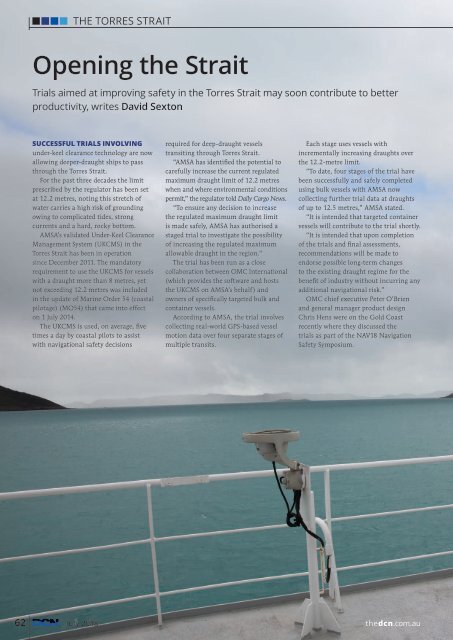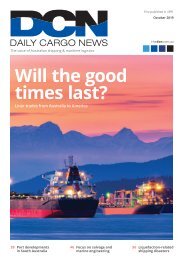DCN0718_Combined_150
Create successful ePaper yourself
Turn your PDF publications into a flip-book with our unique Google optimized e-Paper software.
THE TORRES STRAIT<br />
Opening the Strait<br />
Trials aimed at improving safety in the Torres Strait may soon contribute to better<br />
productivity, writes David Sexton<br />
SUCCESSFUL TRIALS INVOLVING<br />
under-keel clearance technology are now<br />
allowing deeper-draught ships to pass<br />
through the Torres Strait.<br />
For the past three decades the limit<br />
prescribed by the regulator has been set<br />
at 12.2 metres, noting this stretch of<br />
water carries a high risk of grounding<br />
owing to complicated tides, strong<br />
currents and a hard, rocky bottom.<br />
AMSA’s validated Under-Keel Clearance<br />
Management System (UKCMS) in the<br />
Torres Strait has been in operation<br />
since December 2011. The mandatory<br />
requirement to use the UKCMS for vessels<br />
with a draught more than 8 metres, yet<br />
not exceeding 12.2 metres was included<br />
in the update of Marine Order 54 (coastal<br />
pilotage) (MO54) that came into effect<br />
on 1 July 2014.<br />
The UKCMS is used, on average, five<br />
times a day by coastal pilots to assist<br />
with navigational safety decisions<br />
required for deep-draught vessels<br />
transiting through Torres Strait.<br />
“AMSA has identified the potential to<br />
carefully increase the current regulated<br />
maximum draught limit of 12.2 metres<br />
when and where environmental conditions<br />
permit,” the regulator told Daily Cargo News.<br />
“To ensure any decision to increase<br />
the regulated maximum draught limit<br />
is made safely, AMSA has authorised a<br />
staged trial to investigate the possibility<br />
of increasing the regulated maximum<br />
allowable draught in the region.”<br />
The trial has been run as a close<br />
collaboration between OMC International<br />
(which provides the software and hosts<br />
the UKCMS on AMSA’s behalf) and<br />
owners of specifically targeted bulk and<br />
container vessels.<br />
According to AMSA, the trial involves<br />
collecting real-world GPS-based vessel<br />
motion data over four separate stages of<br />
multiple transits.<br />
Each stage uses vessels with<br />
incrementally increasing draughts over<br />
the 12.2-metre limit.<br />
“To date, four stages of the trial have<br />
been successfully and safely completed<br />
using bulk vessels with AMSA now<br />
collecting further trial data at draughts<br />
of up to 12.5 metres,” AMSA stated.<br />
“It is intended that targeted container<br />
vessels will contribute to the trial shortly.<br />
“It is intended that upon completion<br />
of the trials and final assessments,<br />
recommendations will be made to<br />
endorse possible long-term changes<br />
to the existing draught regime for the<br />
benefit of industry without incurring any<br />
additional navigational risk.”<br />
OMC chief executive Peter O’Brien<br />
and general manager product design<br />
Chris Hens were on the Gold Coast<br />
recently where they discussed the<br />
trials as part of the NAV18 Navigation<br />
Safety Symposium.<br />
AMSA<br />
First published in 1891<br />
62 July 2018<br />
thedcn.com.au

















